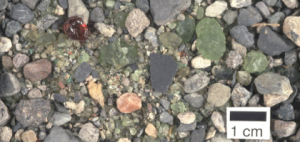
Grains of forsterite (green), of pyrope (red), and of a multitude of rock types. The mix of grains was scooped up from an anthill in northwestern New Mexico. Presumably the builders of the mound, harvester ants, were not sluggards, but promptly rebuilt as to be expected from a biblical proverb.
Doug Smith, UT Austin
Extraordinary serpentine-rich diatremes occur in the interior of the Colorado Plateau. These diatremes have a matrix of serpentinized ultramafic microbreccia; within the matrix are inclusions of sedimentary rock, granite, granulite, eclogite, peridotite, and many other rock types. Discrete grains of forsterite, pyrope, and pyroxene are also scattered throughout the matrix. LA-ICP-MS is being used to analyze both the discrete forsterite grains and also forsterite grains in peridotite inclusions. One goal is to investigate how the mantle lithosphere below continents can be affected by subducting plates of oceanic lithosphere. Preliminary results establish that the discrete forsterite grains have significantly lower concentrations of Al, Cr, V, Ca, and Na than does most mantle olivine. These results confirm that the diatreme roots were in unusually cool mantle.
© 2024 Jackson School of Geosciences, The University of Texas at Austin

